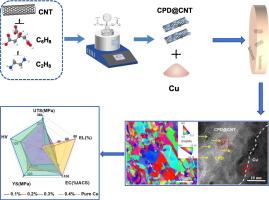Enhanced dispersion and interfacial bonding in CNT/Cu composites via carbonized polymer dot surface engineering of CNT to achieve superior mechanical and electrical properties
IF 5.1
3区 材料科学
Q2 MATERIALS SCIENCE, COATINGS & FILMS
引用次数: 0
Abstract
In the field of energy and electricity, there is an urgent demand for Cu matrix composites with excellent electrical conductivity and mechanical properties. Therefore, in this work, one-step hydrothermal approach was applied to in-situ generate carbonized polymer dot (CPD) for surface modification of carbon nanotube (CNT) without affecting their intrinsic structure. By taking advantage of synergistic effect of CPD@CNT, high electrical conductivity and high strength are obviously produced. This is related to the numerous oxygen-containing functional groups on CPD surface, which contribute notable dispersibility. And during the sintering process, owing to variations in thermal stability, some of these functional groups are thermally decomposed to generate O atoms and it rapidly diffuse into the surrounding Cu atoms to form Cu2O. Additionally, some of CPD structures are thermally decomposed, resulting in the formation of amorphous C, which bonds tightly with the matrix Cu. Consequently, through the “bridging” effect of CPD, the load and electron transfer are improved, and the reinforcing effect of CNT in Cu matrix composites is fully realized. As a result, the 0.3 wt% CPD@CNT/Cu composites possess a high electrical conductivity of 96 %IACS and a remarkable super strength of 341.36 MPa. This study presents an effective strategy for the design of advanced copper matrix composites.

通过碳纳米管的碳化聚合物点表面工程增强碳纳米管/铜复合材料的分散和界面键合,以获得优异的力学和电学性能
在能源和电力领域,对具有优异导电性和力学性能的铜基复合材料有着迫切的需求。因此,本研究采用一步水热法原位生成碳化聚合物点(CPD),在不影响碳纳米管(CNT)固有结构的情况下对其进行表面改性。利用CPD@CNT的协同作用,明显产生高导电性和高强度。这与CPD表面含有大量的含氧官能团有关,这些官能团具有显著的分散性。在烧结过程中,由于热稳定性的变化,这些官能团中的一些被热分解生成O原子,并迅速扩散到周围的Cu原子中形成Cu2O。此外,一些CPD结构被热分解,形成非晶C,与基体Cu紧密结合。因此,通过CPD的“桥接”效应,提高了负载和电子传递,充分实现了碳纳米管在Cu基复合材料中的增强作用。结果表明,0.3 wt% CPD@CNT/Cu复合材料具有96% IACS的高导电性和341.36 MPa的超强强度。本研究为先进铜基复合材料的设计提供了一种有效的策略。
本文章由计算机程序翻译,如有差异,请以英文原文为准。
求助全文
约1分钟内获得全文
求助全文
来源期刊

Diamond and Related Materials
工程技术-材料科学:综合
CiteScore
6.00
自引率
14.60%
发文量
702
审稿时长
2.1 months
期刊介绍:
DRM is a leading international journal that publishes new fundamental and applied research on all forms of diamond, the integration of diamond with other advanced materials and development of technologies exploiting diamond. The synthesis, characterization and processing of single crystal diamond, polycrystalline films, nanodiamond powders and heterostructures with other advanced materials are encouraged topics for technical and review articles. In addition to diamond, the journal publishes manuscripts on the synthesis, characterization and application of other related materials including diamond-like carbons, carbon nanotubes, graphene, and boron and carbon nitrides. Articles are sought on the chemical functionalization of diamond and related materials as well as their use in electrochemistry, energy storage and conversion, chemical and biological sensing, imaging, thermal management, photonic and quantum applications, electron emission and electronic devices.
The International Conference on Diamond and Carbon Materials has evolved into the largest and most well attended forum in the field of diamond, providing a forum to showcase the latest results in the science and technology of diamond and other carbon materials such as carbon nanotubes, graphene, and diamond-like carbon. Run annually in association with Diamond and Related Materials the conference provides junior and established researchers the opportunity to exchange the latest results ranging from fundamental physical and chemical concepts to applied research focusing on the next generation carbon-based devices.
 求助内容:
求助内容: 应助结果提醒方式:
应助结果提醒方式:


